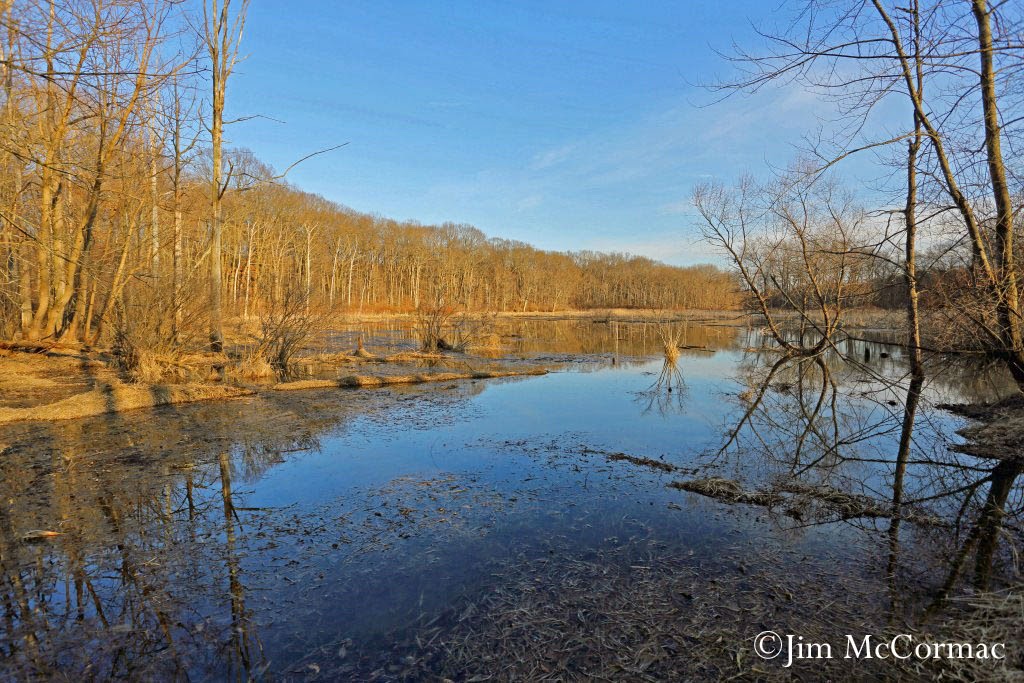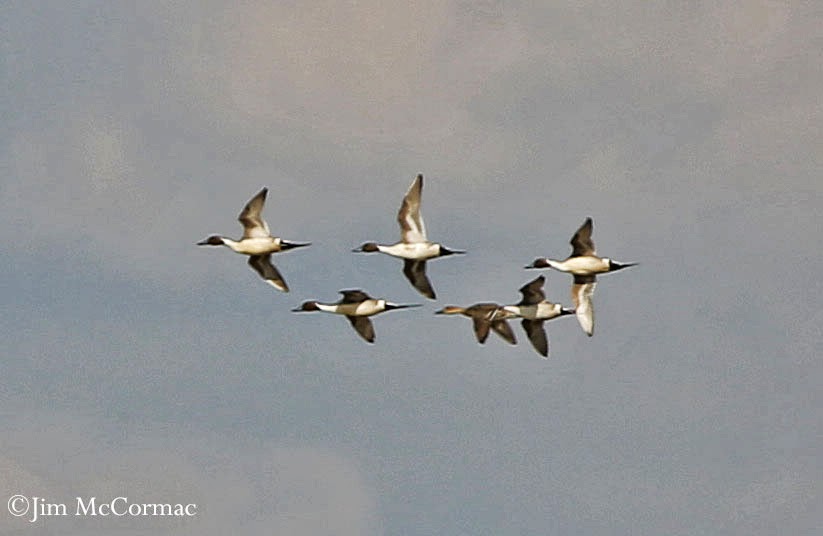Mark your calendars for Saturday, March 29th. That's the date of the now legendary Shreve Migration Sensation (SMS). This is the largest one-day natural history event in the state of Ohio, insofar as I know, and is always a memorable experience. Ground zero for the SMS is the bucolic Wayne County village of Shreve, population about 1,500.
Your narrator is seen here, leaning against a downtown street lamp in front of the Des Dutch Essenhaus, a fabulous Amish restaurant. Indeed, I clutch a bag of freshly baked cookies with an iron fist. If you make the SMS, you must visit the Essenhaus. The village of Shreve nearly doubles its population when the SMS comes to town; last year, there were an estimated 1,400 attendees.
Shreve is ideally suited to host the SMS, in part because it sits on the fringe of one of Ohio's largest wetlands complexes, Killbuck Marsh Wildlife Area. The wildlife area covers nearly 6,000 acres, and is full of life by the end of March.
The school in the center of Shreve plays host to vendors and exhibitors, and there will be six talks covering a range of subjects in the auditorium. These programs begin at 8:30 am, and there is a new one every hour or so. CLICK HERE for the agenda. Yours truly will be giving a talk about Lake Erie and its birds and natural history, which is especially apropos as the brand new Lake Erie Birding Trail guidebook is hot off the presses, having just been released last Wednesday. The 220-page book, which is full of color photos, maps, bird-finding information, other natural history facts, and covers 88 sites along the length of Ohio's lake shore, will be available for sale and it's inexpensive!
I'm in good company as far as speakers. Chuck Jakubchak ("Chuck-J") will be talking about American Kestrels, Cheryl Harner will discuss birding by habitat, Lisa Rainsong will talk up bird songs and how to better learn them, Kim Kaufman will brief us on the Ohio Winter Bird Atlas, and Kenn Kaufman take on bird migration on a global scale.
I found myself in Killbuck and vicinity last Saturday, and saw legions of birds. Killbuck Marsh, with its vast wooded wetlands, hosts scores of Wood Ducks. The open marshes were loaded with diving ducks, with the Ring-necked Duck being especially abundant. Winter has been loath to release its icy grip this spring, and plenty of the wetlands were still locked in ice. As of last weekend, Killbuck was about the northern front lines for waterfowl pushing north. The thaw will certainly be complete by SMS, and visitors can expect big numbers of waterfowl, of just about every possible species.
Just a short drive from Killbuck is Funk Bottoms Wildlife Area, another hotspot for SMS attendees. Here, we see the vast flooded valley from the observation deck on the west side of the wetlands. This distant wide-angle perspective fails to reveal just how many ducks, geese, and swans are out there. In the panorama visible from the tower, I estimated there were about 12,000 waterfowl in view.
We beam in a bit closer. Look at all those fowl! There were 140 Tundra Swans, scores of Canada Geese, two white morph (MORPH, not "phase") Snow Geese, and at least 16 species of ducks. A Red-necked Grebe wasn't far off, on another part of the wetland.
By the time of the SMS, the Tree Swallows will be back in force. I photographed these at an SMS of a few years ago, and the birds were fluffed against 20 F temperatures in the early morning.
A quartet of Northern Shovelers wings by, three gorgeous drakes attending a female. Early spring in the marshes is a fabulous time to witness the courting antics of testosterone-fueled drakes as they battle for the attentions of the hens.
A squadron of Northern Pintails rockets by my camera. Funk Bottoms is probably the most critical stopover site in Ohio for this sleek prairie pothole specialist, or at least it rivals the western marshes of Lake Erie. Pintails were far and away the dominant duck at Funk last Saturday, and I estimated about 8,000 were present.
March 29th and the Shreve Migration Sensation is less than two weeks off, and Killbuck and Funk will still be packed with fowl. I'd encourage you to make the scene - you won't be disappointed. For complete details about SMS, CLICK HERE.
Your narrator is seen here, leaning against a downtown street lamp in front of the Des Dutch Essenhaus, a fabulous Amish restaurant. Indeed, I clutch a bag of freshly baked cookies with an iron fist. If you make the SMS, you must visit the Essenhaus. The village of Shreve nearly doubles its population when the SMS comes to town; last year, there were an estimated 1,400 attendees.
Shreve is ideally suited to host the SMS, in part because it sits on the fringe of one of Ohio's largest wetlands complexes, Killbuck Marsh Wildlife Area. The wildlife area covers nearly 6,000 acres, and is full of life by the end of March.
The school in the center of Shreve plays host to vendors and exhibitors, and there will be six talks covering a range of subjects in the auditorium. These programs begin at 8:30 am, and there is a new one every hour or so. CLICK HERE for the agenda. Yours truly will be giving a talk about Lake Erie and its birds and natural history, which is especially apropos as the brand new Lake Erie Birding Trail guidebook is hot off the presses, having just been released last Wednesday. The 220-page book, which is full of color photos, maps, bird-finding information, other natural history facts, and covers 88 sites along the length of Ohio's lake shore, will be available for sale and it's inexpensive!
I'm in good company as far as speakers. Chuck Jakubchak ("Chuck-J") will be talking about American Kestrels, Cheryl Harner will discuss birding by habitat, Lisa Rainsong will talk up bird songs and how to better learn them, Kim Kaufman will brief us on the Ohio Winter Bird Atlas, and Kenn Kaufman take on bird migration on a global scale.
I found myself in Killbuck and vicinity last Saturday, and saw legions of birds. Killbuck Marsh, with its vast wooded wetlands, hosts scores of Wood Ducks. The open marshes were loaded with diving ducks, with the Ring-necked Duck being especially abundant. Winter has been loath to release its icy grip this spring, and plenty of the wetlands were still locked in ice. As of last weekend, Killbuck was about the northern front lines for waterfowl pushing north. The thaw will certainly be complete by SMS, and visitors can expect big numbers of waterfowl, of just about every possible species.
Just a short drive from Killbuck is Funk Bottoms Wildlife Area, another hotspot for SMS attendees. Here, we see the vast flooded valley from the observation deck on the west side of the wetlands. This distant wide-angle perspective fails to reveal just how many ducks, geese, and swans are out there. In the panorama visible from the tower, I estimated there were about 12,000 waterfowl in view.
We beam in a bit closer. Look at all those fowl! There were 140 Tundra Swans, scores of Canada Geese, two white morph (MORPH, not "phase") Snow Geese, and at least 16 species of ducks. A Red-necked Grebe wasn't far off, on another part of the wetland.
By the time of the SMS, the Tree Swallows will be back in force. I photographed these at an SMS of a few years ago, and the birds were fluffed against 20 F temperatures in the early morning.
A quartet of Northern Shovelers wings by, three gorgeous drakes attending a female. Early spring in the marshes is a fabulous time to witness the courting antics of testosterone-fueled drakes as they battle for the attentions of the hens.
A squadron of Northern Pintails rockets by my camera. Funk Bottoms is probably the most critical stopover site in Ohio for this sleek prairie pothole specialist, or at least it rivals the western marshes of Lake Erie. Pintails were far and away the dominant duck at Funk last Saturday, and I estimated about 8,000 were present.
March 29th and the Shreve Migration Sensation is less than two weeks off, and Killbuck and Funk will still be packed with fowl. I'd encourage you to make the scene - you won't be disappointed. For complete details about SMS, CLICK HERE.







